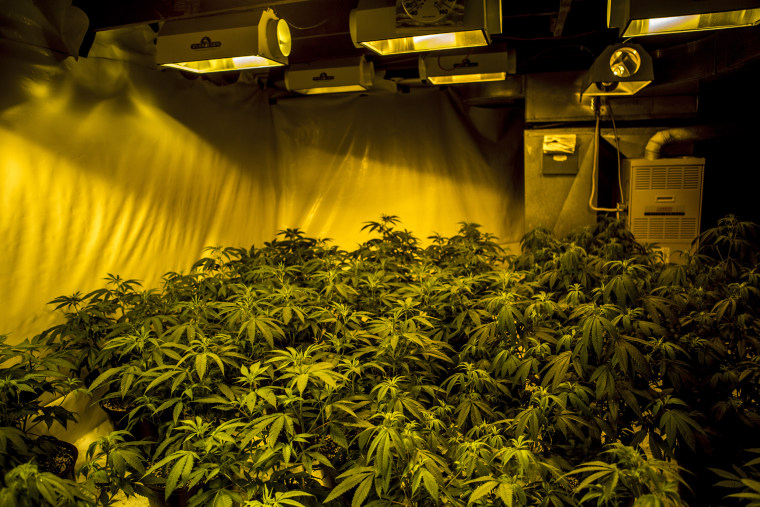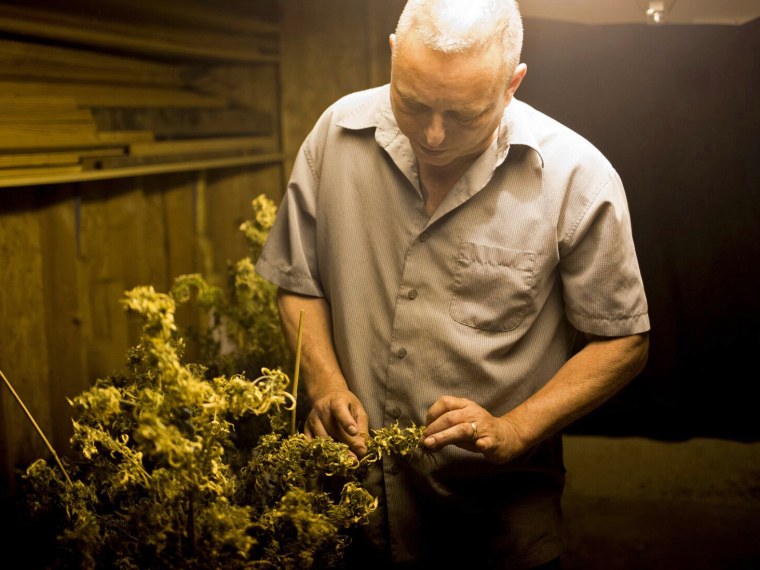SEATTLE — Stephen Damgaard uses medical marijuana for nerve damage in his spine, eating a small brownie made with cannabutter each morning. The weed in the butter comes from one of Seattle’s many medical dispensaries -- an untaxed and illegal medical pot shop that up until now has been tolerated by authorities.
But almost everything about marijuana in Washington is about to change, as the state moves to regulate both its 17-year-old medical marijuana program and the legalization of recreational marijuana passed by voters in 2012. And critics say the changes will hurt the users of medical marijuana. Fear of higher prices, possession limits and lack of access to the specific marijuana products that high-use patients need has left medical marijuana advocacy groups fighting back against laws that both Democrat and Republican legislators see as good.
Most medical marijuana, previously untaxed and almost completely unregulated, must now be purchased in the same regulated retail stores that sell weed to recreational users. In addition to paying a 37 percent tax on purchases, medical marijuana patients face lower possession limits and tight restrictions on growing marijuana in group collectives. By July 1, 2016, the new regulations will be fully in place and medical patients will be part of the retail market.

The Cost of Weed
The recreational system took more than a year to get up and running, with the first shops opening in July 2014. There are now 154, and new users and tourists are major driving forces in growing retail sales.
But cost has been an issue since recreational marijuana was legalized in Washington. Prior to this July, when a 37 percent tax on recreational weed became effective statewide, some locales were charging taxes as high as 50 percent.
Click Here to See All of News21's "America's Weed Rush" Project
Supporters of the new laws say that having everyone participate in the same market will make prices drop in the long run. The idea that retail pot is expensive isn’t accurate now that more than a few shops are up and running, said Seattle City Attorney Pete Holmes, who advocated for heavily for legalization and medical regulation.
“We’re seeing already, even with the limited supply, costs have just really dropped,” Holmes said. “In the last 12 months, prices are probably 50 percent of what they were before. With that kind of movement and that kind of price sensitivity, the legal market is going to beat the illegal market in the marketplace.”
But medical growers estimate the cheapest medical marijuana is selling for between $125 and $140 an ounce, while the cheapest ounces available at Uncle Ike’s and Ocean Greens -- two of Seattle’s most popular retail stores -- are around $190. For a patient like Damgaard, who said he uses three ounces a week, the price difference can add up.
I’m on a fixed income,” Damgaard said. “I can only afford a little bit.”
The Wild West
When medical marijuana was first legalized in Washington in 1998, there wasn’t much to it. Some of the states that legalized later included rulemaking guidelines or regulations in their medical marijuana initiatives. Washington’s ballot initiative only dealt with the basics. For example, a patient needed only a doctor’s recommendation to obtain medical marijuana.
“[Medical marijuana legalization] created an affirmative defense for a patient or designated provider who is authorized by their healthcare provider to possess a 60-day supply of marijuana,” said Kristi Weeks of the Department of Health. “That’s all it created.”
That means that a medical marijuana patient could be arrested for possession, but could use medical authorization as a legal defense at trial.
While the health department would later define a 60-day supply as 24 ounces of marijuana, little else was done to clarify what medical patients could and could not do.
In the absence of regulations, large medical marijuana cultivation cooperatives and dispensaries sprouted around the state. Police and prosecutors mostly tolerated them as an alternative to forcing medical patients to buy weed off the streets, Weeks said.
State lawmakers have responded by trying to cut down on illegal cultivation and sales. Under the new laws, medical patients who previously could possess 24 ounces -- as long as they could prove they needed it if arrested -- are now allowed three. The three ounces are permitted only if they are willing to sign up for the state medical marijuana registry. Unregistered patients are limited to one ounce.
To Joe Mascaro, a medical marijuana patient who legally grows for a handful of friends, the possession limits are going to hurt those who need medical marijuana the most. “For you or me, three ounces seems like a lot,” Mascaro said. “For a cancer patient, they can go through it like that, easily.”
While Mascaro sees this as a state-controlled monopoly, officials see it as increased availability. “[Now] people will be able to purchase from stores, grow in cooperative grows or grow at home,” said Weeks, “so there’s no longer a need for anyone to have 24 ounces at any given moment in time.”

Holmes, the city attorney, said he doesn’t think the three-ounce limit will be enforced on its own other than in cases where a crime has been committed. “It would have to be one of those circumstances akin to lightning striking twice at the same place,” Holmes said. “Where you’re actually in possession (of more than three ounces) and having given a level of suspicion to a law enforcement officer to have them search you. … I haven’t seen it as a practical limitation.”
Growing in a group will also be more challenging for medical marijuana patients under the new regulations. The untracked, unregulated collective gardens are gone, but a way for patients to grow in small groups remains in the form of grow cooperatives.
The cooperatives are allowed a maximum of four patients — who are generally allowed to grow four plants each -- but they must be registered with the state and cannot be within a mile of a marijuana store, a major challenge in places like Seattle. Some growers like Mascaro have already started to shrink their small collectives to personal grows. Some of those with big operations said they are more hesitant to downsize.
“I wish I could figure out how I could continue doing this (legally),” said one grower who feels her collective cannot be licensed because of prior arrests. “I’m not taking this risk for you to resell it, I’m doing this to heal people.”
“If they [the state] are providing what we’re providing,” she said, “if a patient can get quality, 20 [dollars]-per-gram RSO (Rick Simpson Oil, a medical marijuana extract), then I’ll quit.”
This report is part of the project titled “America’s Weed Rush,” produced by the Carnegie-Knight News21 initiative, a national investigative reporting project involving top college journalism students across the country and headquartered at the Walter Cronkite School of Journalism and Mass Communication at Arizona State University.